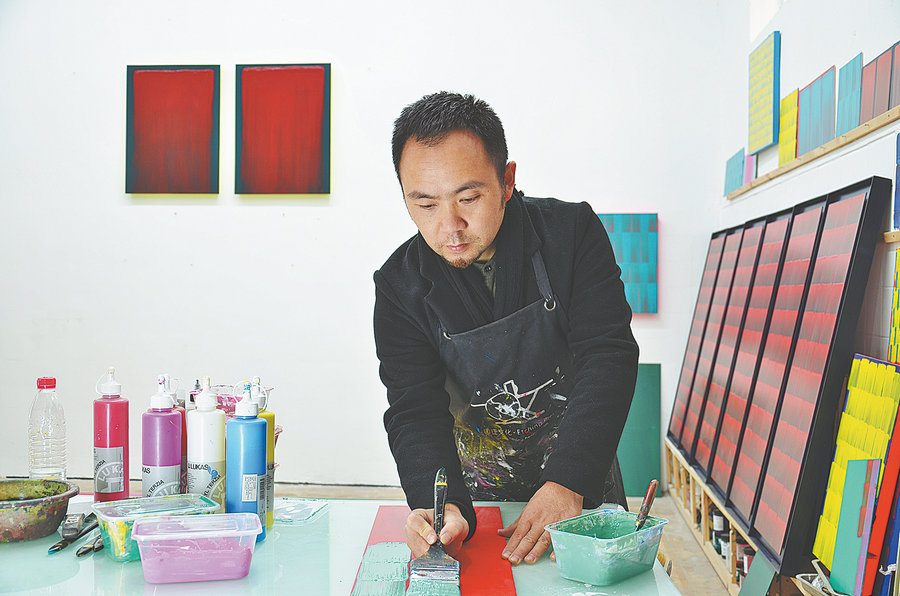Exhibition puts ties in the frame


Dialogue through time
The Guimet Museum has one of the world's richest collections of Asian art, and its Chinese section contains about 20,000 artworks, covering art from the origins of its civilization to around the 18th century. This time, the museum opened its cabinets and invited the artists to start a dialogue through time and space with these precious collections.
The 20 participating artists use their creativity and artistic language to paint the bridge between Western contemporary art and Chinese tradition.
The art piece 3,000 Quiddities Inherently Entailed in Each Moment of Experience NO 70-3 is Peng's first-time tryout on a round pottery plate.
"The creation style is the same as other works in the same series, with brushstrokes repeated until the disc is filled," Peng says.
"I paid special attention to the painting process, let myself be in a state of relaxation and concentration, and strived to make myself feel every moment clearly, just like the self-cultivation of a monk. When I first conceived of the disc, I wanted to bring out its morphological characteristics. In the past, I used a quadrilateral frame to create the work, and the strokes were all oriented in one direction, whereas in a round shape, it radiates from the center to the surrounding. The final effect of blue is like an eye or a black hole, adding more mystery. Its color and shape exceed my expectations and bring more imagination to the audience."
Within the rooms of the Chinese ceramic collection, Yishu 8 Prize winners were invited to choose an object "in resonance" with their approach, then to write postcards to other artists in which through a few sentences or a pictorial gesture reveals the way in which this object "speaks today" to the artist.
On these 39 postcards, some artists focus on painting, some "experiment" on postcards, and some simply abandon the original paper and start new creations. The Guimet Museum displays these postcards and their corresponding cultural relics side by side.
Peng, with his signature fluorescent colors and lines, presents the elegant color and luster of yellowglazed porcelain in the Hongzhi period of the Ming Dynasty (1368-1644).
"I chose the yellow and blue porcelains, using the same radiating lines. I only used a very light color to outline the central object, but the lines were replaced with the color of the objects, which is also a metaphor for the fragility of cultural relics. Its light will eventually dissipate in the vast river of history, and the color will also recede," he says.
"We often say that Yishu 8 is like a big family, growing together in mutual love. The prize is like the starting point of my art. It has given me a lot of opportunities to make my artistic path smoother. After winning the prize, I had a solo exhibition in Beijing in 2014; in 2015, I had a residency exchange in Paris. I hope to have better development in the future, benefit more young artists from China and France, and promote the cultural exchanges."
Claire Tabouret, the 2012 Yishu 8 Prize winner, with her delicate brushstrokes and colors, makes the silverware of the Liao Dynasty (916-1125) alive on paper.
Wang, winner of the 2015 prize, uses soap and resin to pay tribute to the celadon of the Longquan kiln of the Southern Song Dynasty (1127-1279).
In the main hall, in addition to Sabatte's monumental sculpture and Wang's installation, the video artwork Hai Gongzi took Geng Xue, the 2016 prize winner, a year to finish the filming of how the figurines and props are made in ceramics.
Against a backdrop of the ancient ceramics in the exhibition hall, the video work has injected new life into the relics.
The neoclassical Heidelbach Hotel, an annex of the Guimet Museum, serves as the main exhibition hall for the artists of Yishu 8. Jennifer Douzenel, the 2013 prize winner, who has also worked as the designer of the exhibition, separates the space with a velvet column area, and adds mysterious lighting to create a field of exploration, similar to the layout concept of Chinese gardens that capture limitless beauty on moving steps.
She has created a unique and undisturbed exhibition and viewing space for each artist and each artwork.
Visitors can see a corner of the work from a distance, and when they get closer, it gets more mysterious, until finally they are completely immersed in the artist's world.
The sculpture Versant by the 2018 prize winner Flavie L.T. is placed in the courtyard to take the audience on a tour of Chinese philosophy of a celestial landscape.
Sculpture fraiche by the 2017 prize winner Guillaume Talbi is like the rockery in Chinese gardens, with different perspectives for multifaceted viewing.
The exhibition hall on the first floor presents 19 paintings, sculptures, installations and video works, including artist Li Xin's oil painting 20210919H on canvas.
The 2018 winner Ouyang Sulong's 3D-printed painting Broken Shadow Series is the center of attention; the 2019 winner Cai Yaling's embroidery work on photo Me in 1987 brings a rare feeling of intimacy; and Lyes Hammadouche exhibits his whimsical installation Law, showcasing the flow of light and time.
























